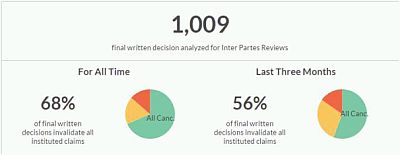The AIA 5-Years In: Looking Back at the Provisions That Have Re-Shaped Patent Law and Those That Are Largely Forgotten
Nearly five years have passed since enactment of the America Invents Act ("AIA"), which was arguably the most significant intellectual property legislation since the Copyright Act of 1976. Many provisions of the AIA have had a significant effect on the patent system, while others, somewhat surprisingly, have been mostly forgotten.
Provisions of the AIA That Have Had a Significant Effect on Patent Law
Post-Grant Review Proceedings
The creation of post-grant review proceedings, including, among others, inter partes reviews ("IPRs"), has fundamentally shifted patent litigation strategy. The U.S. Patent and Trademark Office ("USPTO") originally anticipated about 460 IPR petitions per year. However, early IPR results heavily favored petitioners, and quickly led to a wave of filings far exceeding initial expectations. Filing rates now total around 150 petitions per month, nearly four times the number originally anticipated. Representative IPR filing statistics and results are shown below:1


Anecdotally, IPR petitioner success rates, and the possibility of multiple challenges by different accused infringers (or third parties, such as defensive trade associations), have deterred at least some amount of litigation, and reduced settlement figures in others.
First-to-File System
The AIA moved the U.S. from a first-to-invent to a first-inventor-to-file system. Implementation of these changes, however, was delayed until March 16, 2013, meaning that the initial wave of "first-to-file" applications has only recently begun to issue. The effects of these changes, and related changes to the scope of available "prior art," are still unfolding.
Best Mode
The AIA also eliminated the Best Mode requirement of 35 U.S.C. § 112 as a litigation defense. Specifically, the AIA amended 35 U.S.C. § 282, effective upon enactment, to state that "failure to disclose the best mode shall not be a basis on which any claim of a patent may be canceled or held invalid or otherwise unenforceable." This amendment favored patentees, eliminating this invalidity risk and the associated discovery burden.
False Marking
The AIA eliminated the qui tam provision of the false marking statute, and thereby cut off a wave of lawsuits brought by plaintiffs that had suffered no actual injury of their own. In Forest Group, Inc. v. Bon Tool Co., 590 F.3d 1295 (Fed. Cir. 2009), the Federal Circuit held that penalties for false marking should be on a per article basis rather than a per decision basis, leading to a wave of lawsuits by plaintiffs looking to make a quick profit. In 2010 alone, more than 630 false marking suits were filed. The AIA changed this rule, and limited non-U.S. government false marking lawsuits to persons suffering competitive injuries. Recovery was also limited to damages adequate to compensate for that injury.
Joinder under Section 299
The AIA added 35 U.S.C. § 299, which eliminated the common practice of plaintiffs joining in a single lawsuit multiple unrelated parties accused of infringing the same patents. Section 299 provides that accused infringers could be joined in one action, or consolidated for trial, only if: (1) any right to relief arises "out of the same transaction, occurrence, or series of transactions or occurrences relating to the making, using, importing into the United States, offering for sale, or selling of the same accused product or process;" and (2) "questions of fact common to all defendants or counterclaim defendants will arise in the action."
Following enactment of this provision, plaintiffs were forced to file different lawsuits against different defendant groups, even when accused of infringing the same patent in similar ways. As a practical matter, courts routinely consolidate for discovery contemporaneously-filed lawsuits involving the same patent(s), but this provision still gives defendants a distinct advantage (vis-a-vis pre-AIA practice) since they are guaranteed separate trials. This provision allows multiple opportunities to invalidate the same patent based on the same prior art. The same advantage holds true for cases transferred and consolidated by the Judicial Panel on Multidistrict Litigation, which saw modestly more patent cases following the enactment of the AIA.2
Largely Forgotten AIA Provisions
While many AIA provisions have fundamentally changed patent practice, other significant amendments have been largely forgotten by practitioners.
Citations of Prior Art and Written Statements
The AIA amended 35 U.S.C. § 301 to expand the scope of material that "any person" can submit to the USPTO and make part of the official file history. Prior to the AIA, Section 301 only permitted citation of prior art materials; the amended section now allows citation of "statements of the patent owner filed in a proceeding before a Federal court or the Office in which the patent owner took a position on the scope of any claim of a particular patent." There is no fee associated with the submission and it can be kept anonymous. All that is required is an explanation of the pertinence of the statements or prior art. Section 301(d) indicates that written statements will only be considered in an "ordered or instituted" ex parte reexamination, inter partes review, or post-grant review. The USPTO has interpreted this to mean that the statements cannot be considered at the initial request or petition phase.3 To the authors' knowledge, this amended section has rarely been used.
Nevertheless, there could be reasons why interested parties should reconsider its usefulness. For example, it is free, can be kept anonymous, and does not come with any associated estoppel risk. Moreover, it may put the burden on the patent owner to seek reexamination or reissue before bringing a lawsuit; assertion of patent claims that are objectively invalid could result in fee-shifting under 35 U.S.C. § 285 and the Supreme Court's decision in Octane Fitness.4 Moreover, submission of prior art and written statements could give another (better-funded) third party ammunition to file an IPR or ex parte reexamination challenge.
To view the full NewsLetter please click here
Footnotes
1 Statistics and graphs courtesy of Docket Alarm, Inc.
2 Dongbiao Shen, Misjoinder or Mishap? The Consequences of the AIA Joinder Provision, 29 BERKELEY TECH. L.J. 545, 567–68 (2014).
3 See, e.g., 37 C.F.R. § 1.552.
4 Octane Fitness, LLC v. Icon Health & Fitness, Inc., — U.S. —, 134 S.Ct. 1749 (2014).
The content of this article is intended to provide a general guide to the subject matter. Specialist advice should be sought about your specific circumstances.






